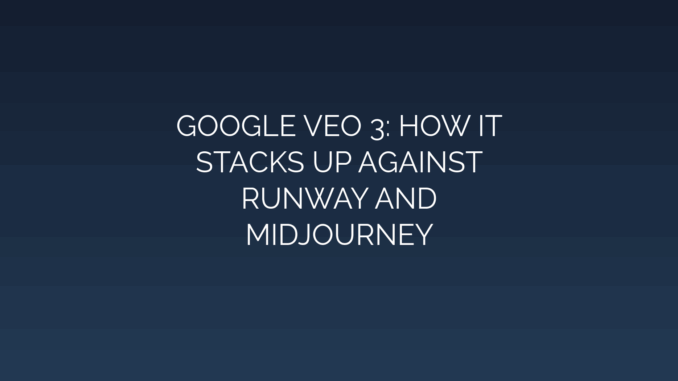
Google Veo 3: How It Stacks Up Against Runway and Midjourney
The AI video generation landscape is evolving rapidly, with leading platforms like Google Veo 3, Runway Gen3, and Midjourney vying for dominance. Each tool brings unique strengths to creative workflows, from cinematic fidelity to stylistic versatility. This analysis examines how Google Veo 3 compares to its rivals in capabilities, accessibility, and practical applications for AI content creation.
The Contenders: Core Technologies
Google Veo 3 As Google DeepMind’s flagship texttovideo model, Veo 3 emphasizes video quality and coherence. It uses advanced diffusion transformers trained on diverse visual data to generate highresolution (1080p) clips up to 60 seconds. Key strengths include:
- Photorealistic motion: Fluid simulations of physics (e.g., water, cloth).
- Temporal consistency: Minimal object flickering across frames.
- Prompt adherence: Precise interpretation of complex prompts (“a time-lapse of a glacier melting under aurora borealis”).
Currently accessible via private waitlist, it integrates with YouTube Shorts and other Google Creative tools.
Runway Gen3 Runway focuses on empowering filmmakers with granular control over video synthesis. Its Gen3 Alpha model supports:
- Multimodal inputs: Images + text prompts generate dynamic sequences.
- Motion controls: Customize movement paths and camera angles.
- Real-time editing: Modify scenes via inpainting or frame rewrites.
Popular for commercial storytelling, Runway operates on a freemium model, with subscriptions starting at $15/month.
Midjourney Midjourney dominates AI image generation but has expanded into video via limitedmotion “turbo” clips (5–10 seconds). Its signature traits:
- Artistic styles: Strong painterly or surreal aesthetics.
- Community-driven iteration: Users refine outputs via Discord feedback loops.
- Rapid ideation: Generates 4 image variants per prompt in seconds.
Video features remain experimental, available to toptier subscribers ($96/month).
Comparative Analysis: Key Factors
Video Quality and Realism
- Google Veo 3: Leads in naturalism—hair, smoke, and lighting mimic real-world physics. 60-second clips maintain coherence in long sequences.
- Runway: Excels in cinematic detail with adjustable shot compositions but struggles with limb articulation in humans.
- Midjourney: Prioritizes texture and artistry over motion fluidity, resulting in stylized but often jerky animations.
Verdict: Veo wins for lifelike fidelity; Runway for directorial control; Midjourney for static imagery.
Prompt Handling and Creativity
- Veo 3: Interprets layered prompts (“a steampunk owl reading a newspaper in a rainy alley”) accurately but requires precise phrasing.
- Runway: Adapts well to abstract concepts (e.g., “melting clocks in a desert”), leveraging image-to-video flexibility.
- Midjourney: Unmatched in stylistic range—from Van Gogh-inspired landscapes to cyberpunk portraits—but less adaptable for dynamic scenes.
Verdict: Midjourney for artistic experimentation; Runway for surrealism; Veo for realism.
Accessibility and Integration
- Veo 3: Tightly integrated with Google’s ecosystem (potential Google Photos/Kinemaster synergy), but limited to a closed beta.
- Runway: User-friendly web interface; exports to Premiere Pro/Final Cut via plugins. Free tier available.
- Midjourney: Requires Discord navigation—less intuitive for video workflows.
Verdict: Runway offers the smoothest onboarding; Veo has longterm ecosystem potential.
Pricing Models | Platform | Cost Structure | Video Length Limits | |||| | Google Veo 3 | Unannounced (beta) | Up to 60 seconds | | Runway Gen3 | $15–$95/month | 10–125 seconds | | Midjourney | $10–$96/month | 5–10 seconds | Runway’s limits vary by subscription tier.
Practical Use Cases
- Marketing & Advertising:
- Veo 3: Create high-quality product demos (e.g., “a drone soaring over a rainforest”).
- Runway: Rapid storyboard iterations for campaign concepts.
- Independent Film:
- Runway: Scene prototyping with controlled camera movements.
- Veo 3: Generating B-roll (e.g., establishing shots of futuristic cities).
- Social Media Content:
- Midjourney: Static visuals for thumbnails or Instagram.
- Veo 3/Runway: Short videos optimized for TikTok/YouTube.
The Future of AI Video Generation
Google Veo 3’s emphasis on photorealistic synthesis positions it as a tool for professional filmmakers, while Runway’s editable workflows democratize creative iteration. Midjourney, meanwhile, remains a powerhouse for ideation and artistic styles despite lagging in motion technology. Key developments to watch: 1. Extended duration: Tools overcoming the “10second barrier.” 2. Sound integration: Adding AIgenerated audio to video clips. 3. Ethical safeguards: All three platforms face scrutiny over copyright and deepfake risks.
Final Thoughts
For video quality and realism, Google Veo 3 is the emerging leader. Runway Gen3 dominates creative flexibility, making it ideal for agile production teams. Midjourney, while trailing in motion, retains its edge for visually stunning conceptual work. As AI content creation advances, the “best” tool depends on specific needs—lifelike sequences (Veo), artistic control (Runway), or rapid prototyping (Midjourney).
The race hinges on accessibility: if Veo’s public launch democratizes its potential, it could redefine standards for generative AI in video. For now, creators benefit from healthy competition driving rapid innovation in texttovideo models.
Leave a Reply